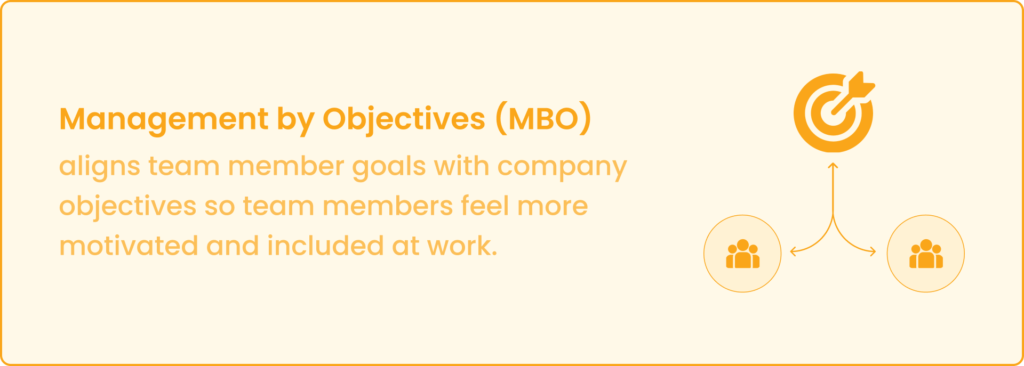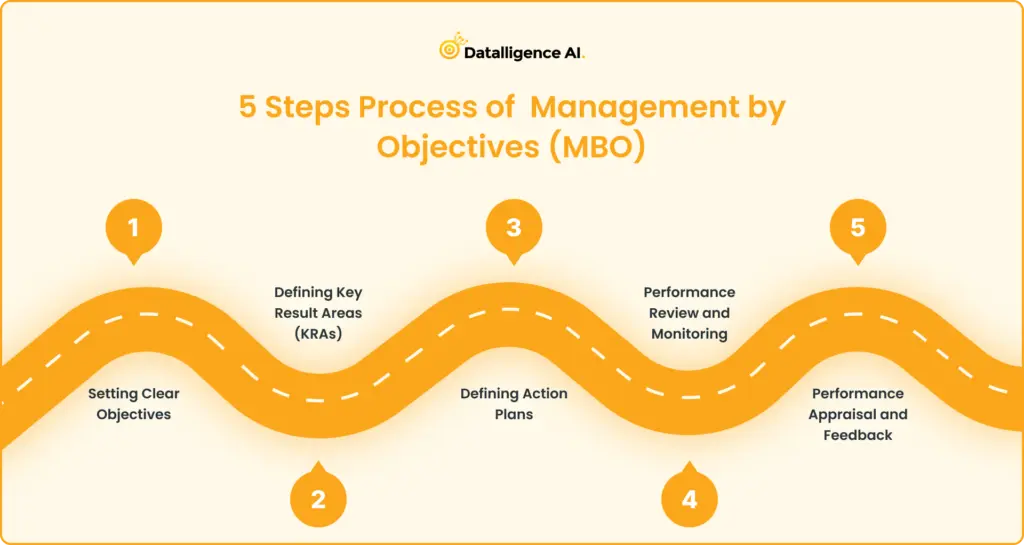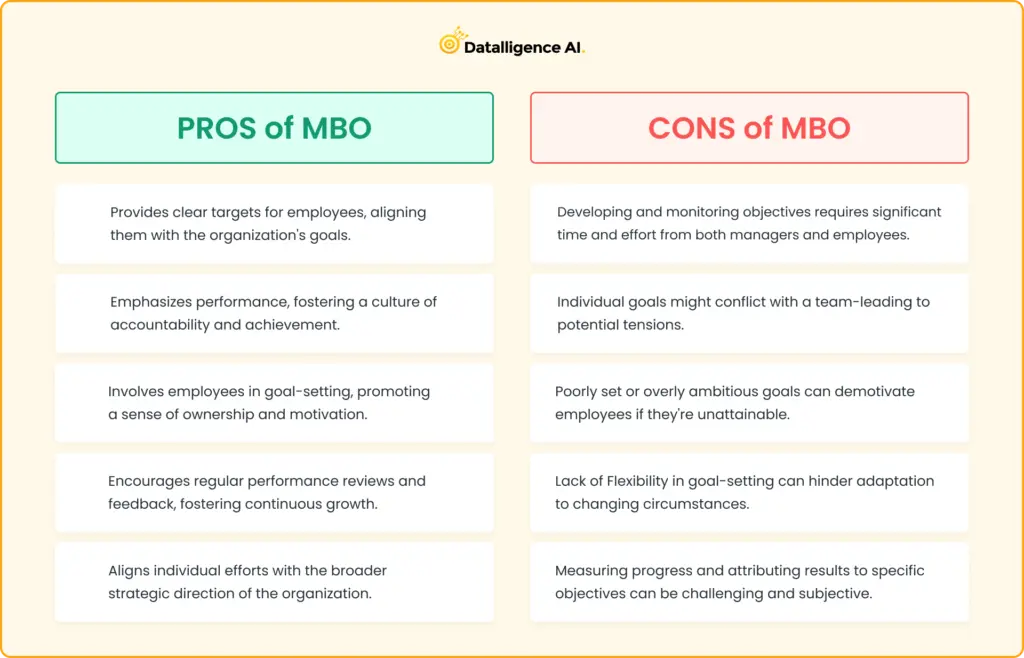Organizations of all kinds must need an effective management framework to achieve their goals, to create alignment and accountability among their employees. One such framework is Management By Objective (MBO).
It’s a systematic and collaborative goal-setting process that has proven to be highly effective in enhancing organizational performance. In this blog, we will delve into the definition, benefits, and examples of Management by Objectives.

What is Management By Objectives?
Management by Objectives, often referred to as MBO, is a management philosophy and technique introduced by Peter Drucker in his 1954 book “The Practice of Management.”
At its core, MBO is a goal-setting process that aims to improve organizational performance by defining specific objectives and aligning the efforts of individuals and teams toward achieving those objectives.

In the MBO (Management by Objectives) framework, objectives are established through a collaborative effort that integrates insights from both managers and employees. These objectives are meticulously crafted to adhere to the SMART criteria, which demands that they be Specific, Measurable, Achievable, Relevant, and Time-bound. By adhering to these principles, the framework ensures that the set objectives hold genuine significance and are realistically attainable within designated timeframes.
Furthermore, the MBO process isn’t a one-time event but rather an ongoing cycle that includes frequent reviews and assessments. These periodic evaluations serve the purpose of not only tracking the advancement toward goals but also of making necessary adjustments to optimize performance.
At its core, the MBO process underscores the importance of aligning goals, quantifying performance, and maintaining a consistent practice of reviewing progress, all of which contribute to enhanced organizational effectiveness and employee engagement.
5 Steps Process of Management by Objectives (MBO)

STEP 1 – Setting Clear Objectives
In this step, managers and their subordinates collaboratively set specific, measurable, achievable, relevant, and time-bound (SMART) objectives. These objectives should be aligned with the overall goals of the organization and provide a clear direction for the individual or team.
Example:
- Assume you are a manager at a software company. One of your team’s objectives could be to “Increase user engagement on the company’s mobile app by 20% within the next quarter.”
- This objective is specific (increase user engagement), measurable (20% increase), achievable (with the right strategies), relevant (to the company’s goals), and time-bound (within the next quarter).
STEP 2 – Defining Key Result Areas (KRAs)
Key Result Areas are the critical areas of focus that need to be addressed in order to achieve the set objectives. These areas help to prioritize tasks and allocate resources effectively. Each objective may have one or more associated KRAs that need to be managed and achieved.
Example:
Continuing with the software company example, the KRAs for the
Objective: Increase user engagement
- KR 1: Enhance user interface design
- KR 2:Implement personalized recommendation algorithms
- KR 3:Launch a user feedback mechanism.
These KRAs represent the key areas that must be focused on to achieve the objective.
STEP 3-Defining Action Plans
Once the objectives and KRAs are established, detailed action plans are developed. Action plans outline the specific steps, activities, and tasks required to accomplish the objectives and KRAs. Each action plan should include responsibilities, timelines, resources needed, and any other relevant details.
Example:
For the “Enhance user interface design” KRA, the action plan could involve tasks like
- Conduct user research to identify pain points in the current design
- Collaborate with the design team to create mockups of the improved interface
- A/B test different designs with a subset of users
Each task should have a responsible person, deadlines, and necessary resources outlined.
STEP 4 -Performance Review and Monitoring
Regular performance reviews are conducted to monitor progress toward achieving the objectives and KRAs. This involves measuring actual performance against the established targets and identifying any deviations or gaps. Feedback is provided to employees, and adjustments can be made to action plans if needed.
Example:
In the middle of the quarter, you review the user engagement metrics and find that there’s only been a 10% increase in engagement instead of the targeted 20%.
This triggers a performance review meeting with the team. You discuss the factors contributing to the gap and decide whether any adjustments to the action plan are necessary.
STEP 5 -Performance Appraisal and Feedback
At the end of the defined period (often annually), a formal performance appraisal is conducted. This involves assessing the extent to which the objectives and KRAs were achieved. Feedback is provided on both successes and areas for improvement, and employees and managers can discuss strategies for enhancing performance in the future.
Example:
At the end of the quarter, you hold a performance appraisal meeting with each team member. You provide feedback on their contributions to the user engagement objective and review their achievements in each KRA.
For instance, if the “Enhance user interface design” KRA had a successful outcome, you acknowledge the team’s efforts and the positive impact it had on user engagement. You also discuss any lessons learned and strategies for further improving user engagement in the next quarter.
Pros and Cons of MBO
While MBO can have both positive and negative aspects, it’s important to note that its effectiveness can vary depending on the organization’s culture, structure, and implementation.

Real-World MBO Examples
There are many fields that can utilize and potentially benefit from MBO. Here are some real-world examples of how MBO can be used:
Sales Department
In a sales team, an MBO could involve setting a specific target for each sales representative to increase their monthly sales by a certain percentage. This aligns with the organization’s goal of boosting revenue.
- Achieve $1.5M monthly sales revenue.
- Increase closed deals by 20% this quarter.
- Maintain a 90%+ customer retention rate.
- Secure three new high-value clients.
- Improve sales team’s call-to-close ratio by 15%.
Marketing Team
For a marketing team, an MBO could be focused on increasing the company’s social media engagement by a certain number over a quarter. This contributes to the broader objective of enhancing the brand’s online presence.
- Launch 2 targeted campaigns this quarter.
- Boost website traffic by 30% organically.
- Generate 500 leads via a webinar.
- Increase social media engagement by 15%.
- Develop and release a viral marketing video.
IT Department
In an IT department, an MBO might involve reducing the average response time for resolving technical issues by a specific duration, contributing to improved customer satisfaction and operational efficiency.
- Maintain system downtime below 1%.
- Ensure zero data breaches with a cybersecurity plan.
- Attain 95% user satisfaction for IT support.
- Implement cloud-based backup and disaster recovery.
- Reduce average response time for technical issues by 25%.
Remember, the key to effective MBOs is to make them specific, measurable, achievable, relevant, and time-bound (SMART) to ensure they drive performance and alignment toward organizational goals.
How MBO Compares to Alternatives
MBO paved the way for many modern-day and commonly used management systems. Here are three popular alternative styles and systems of management and a brief description of what they entail:
1. OKR (Objectives and Key Results):
OKR is a goal-setting framework that is gaining popularity in many organizations, particularly in the tech industry. Like MBO, OKRs involve setting objectives, but they emphasize using key results (specific and measurable outcomes) to track progress.
OKRs are often more agile and adaptable than traditional MBO, which can make them more suitable for fast-paced and innovative environments.
Datalligence is a game-changing OKR software that empowers businesses to align, execute, and achieve their strategic goals with precision. With its user-friendly interface and powerful features, it simplifies the entire OKR process, from setting objectives and key results to tracking progress and driving results.
Try it today and witness the transformative impact on your business.
2. Balanced Scorecard (BSC):
The Balanced Scorecard (BSC) framework enhances performance assessment by incorporating financial and non-financial metrics, such as customer satisfaction, internal processes, and learning and growth. Unlike the narrower focus of Management by Objectives (MBO), which centers on individual or departmental targets, the BSC promotes a holistic approach that aligns organizational strategy across various dimensions, ensuring comprehensive and sustainable success.
3. Six Sigma:
Six Sigma is a methodology rooted in data-driven process enhancement, striving to minimize defects and inconsistencies. It indirectly impacts management practices by fostering a culture of continuous improvement and efficiency.
Unlike Management by Objectives (MBO), which centers on meeting specific performance goals, Six Sigma places its emphasis on quantifying and enhancing process quality, contributing to a more streamlined and error-reduced operational environment.
Datalligence: Helping Implement MBO Successfully
Implementing Management by Objectives effectively requires the right tools and frameworks. This is where Datalligence comes into play.
Datalligence is a comprehensive performance management software that aids organizations in setting, tracking, and achieving their objectives. It provides features such as goal setting, progress tracking, real-time analytics, and collaborative tools that facilitate the MBO process.
With Datalligence, organizations can:
- Set SMART (Specific, Measurable, Achievable, Relevant, Time-bound) objectives for employees and teams.
- Monitor progress and receive real-time updates on goal attainment.
- Foster collaboration through transparent communication and feedback channels.
- Gain insights through data analytics to make informed decisions about performance improvement.
By utilizing Datalligence, organizations can streamline and optimize the MBO process, ensuring that objectives are met efficiently and effectively.
With Datalligence’s support, organizations can confidently navigate the complexities of MBO, ensuring the successful achievement of objectives and the overall growth and success of the business. Elevate your performance management approach today with Datalligence and experience the transformative power of well-executed MBO.











